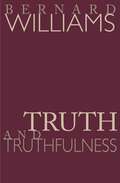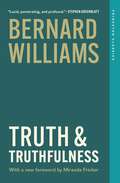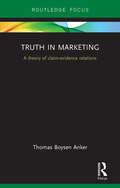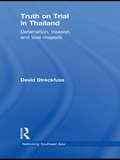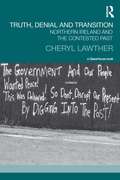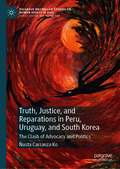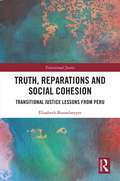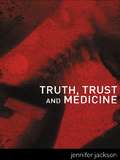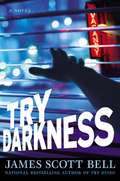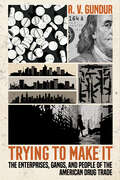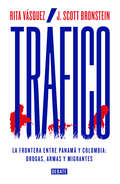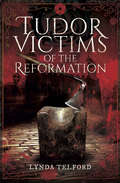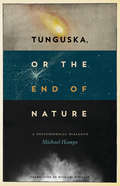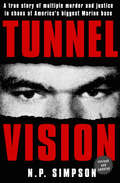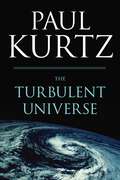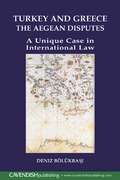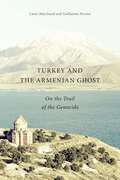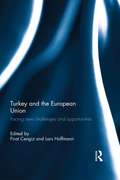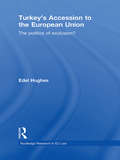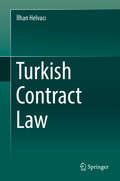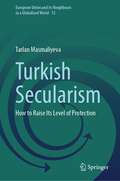- Table View
- List View
Truth and Truthfulness: An Essay in Genealogy
by Bernard WilliamsWhat does it mean to be truthful? What role does truth play in our lives? What do we lose if we reject truthfulness? No philosopher is better suited to answer these questions than Bernard Williams. Writing with his characteristic combination of passion and elegant simplicity, he explores the value of truth and finds it to be both less and more than we might imagine. Modern culture exhibits two attitudes toward truth: suspicion of being deceived (no one wants to be fooled) and skepticism that objective truth exists at all (no one wants to be naive). This tension between a demand for truthfulness and the doubt that there is any truth to be found is not an abstract paradox. It has political consequences and signals a danger that our intellectual activities, particularly in the humanities, may tear themselves to pieces. Williams's approach, in the tradition of Nietzsche's genealogy, blends philosophy, history, and a fictional account of how the human concern with truth might have arisen. Without denying that we should worry about the contingency of much that we take for granted, he defends truth as an intellectual objective and a cultural value. He identifies two basic virtues of truth, Accuracy and Sincerity, the first of which aims at finding out the truth and the second at telling it. He describes different psychological and social forms that these virtues have taken and asks what ideas can make best sense of them today. Truth and Truthfulness presents a powerful challenge to the fashionable belief that truth has no value, but equally to the traditional faith that its value guarantees itself. Bernard Williams shows us that when we lose a sense of the value of truth, we lose a lot both politically and personally, and may well lose everything.
Truth and Truthfulness: An Essay in Genealogy (Princeton Classics)
by Bernard WilliamsWhat does it mean to be truthful? What role does truth play in our lives? What do we lose if we reject truthfulness? No philosopher is better suited to answer these questions than Bernard Williams. Writing with his characteristic combination of passion and elegant simplicity, he explores the value of truth and finds it to be both less and more than we might imagine.Modern culture exhibits two attitudes toward truth: suspicion of being deceived (no one wants to be fooled) and skepticism that objective truth exists at all (no one wants to be naive). This tension between a demand for truthfulness and the doubt that there is any truth to be found is not an abstract paradox. It has political consequences and signals a danger that our intellectual activities, particularly in the humanities, may tear themselves to pieces.Williams's approach, in the tradition of Nietzsche's genealogy, blends philosophy, history, and a fictional account of how the human concern with truth might have arisen. Without denying that we should worry about the contingency of much that we take for granted, he defends truth as an intellectual objective and a cultural value. He identifies two basic virtues of truth, Accuracy and Sincerity, the first of which aims at finding out the truth and the second at telling it. He describes different psychological and social forms that these virtues have taken and asks what ideas can make best sense of them today.Truth and Truthfulness presents a powerful challenge to the fashionable belief that truth has no value, but equally to the traditional faith that its value guarantees itself. Bernard Williams shows us that when we lose a sense of the value of truth, we lose a lot both politically and personally, and may well lose everything.
Truth in Marketing: A theory of claim-evidence relations (Routledge Focus on Business and Management)
by Thomas Boysen AnkerCan we believe the claims that marketers make? Does truth in marketing matter? Apparently not… Despite the role of regulators, marketing claims are often ruled to be misleading, deceptive or incomplete. Surprisingly, scholars of marketing ethics have devoted little time to this key issue. This may be because although key codes of marketing conduct insist on truthful communications, there is only limited understanding of what truthfulness itself actually entails. This innovative book develops a theory of truth in marketing and discusses the implications for consumers, marketing professionals and policymakers. Focusing on the problem of truth in marketing, it analyses the theory of truth in marketing, and examines the wider significance of marketing truth for society. Using a wide selection of engaging global examples and cases to illustrate this fascinating analysis, this engaging book will provide a provocative read for all scholars and educators in marketing, marketing/business ethics and CSR.
Truth on Trial in Thailand: Defamation, Treason, and Lèse-Majesté (Rethinking Southeast Asia)
by David StreckfussSince 2005, Thailand has been in crisis, with unprecedented political instability and the worst political violence seen in the country in decades. In the aftermath of a military coup in 2006, Thailand’s press freedom ranking plunged, while arrests for lèse-majesté have skyrocketed to levels unknown in the modern world. Truth on Trial in Thailand traces the 110-year trajectory of defamation-based laws in Thailand. The most prominent of these is lèse-majesté, but defamation aspects also appear in laws on sedition and treason, the press and cinema, anti-communism, contempt of court, insulting of religion, as well as libel. This book makes the case that despite the appearance of growing democratization, authoritarian structures and urges still drive politics in Thailand; the long-term effects of defamation law adjudication has skewed the way that Thai society approaches and perceives "truth." Employing the work of Habermas, Foucault, Agamben, and Schmitt to construct an alternative framework to understand Thai history, Streckfuss contends that Thai history has become "suspended" since 1958, and repeatedly declining to face the truth of history has set the stage for an endless state of crisis. This book will be of interest to students and scholars of South East Asian politics, Asian history, and media and communication. David Streckfuss is an independent scholar who has lived in Thailand for more than 20 years. His work primarily concerns human rights, and political and cultural history.
Truth, Denial and Transition: Northern Ireland and the Contested Past
by Cheryl LawtherTruth, Denial and Transition: Northern Ireland and the Contested Past makes a unique and timely contribution to the transitional justice field. In contrast to the focus on truth and those societies where truth recovery has been central to dealing with the aftermath of human rights violations, comparatively little scholarly attention has been paid to those jurisdictions whose transition from violent conflict has been marked by the absence or rejection of a formal truth process. This book draws upon the case study of Northern Ireland, where, despite a lengthy debate, the question of establishing a formal truth recovery process remains hotly contested. The strongest and most vocal opposition has been from unionist political elites, loyalist ex-combatants and members of the security forces. Based on empirical research, their opposition is unpicked and interrogated at length throughout this book. Critically exploring notions of national imagination and blamelessness, the politics of victimhood and the tension between traditions of sacrifice and the fear of betrayal, this book is the first substantive effort to concentrate on the opponents of truth recovery rather than its advocates. This book will interest those studying truth processes and transitional justice in the fields of Law, Politics, and Criminology.
Truth, Justice, and Reparations in Peru, Uruguay, and South Korea: The Clash of Advocacy and Politics (Palgrave Macmillan Studies on Human Rights in Asia)
by Ñusta Carranza KoThis book presents the first cross-regional analysis of post-transitional justice periods and the conditions that influence states’ behaviors. Specifically, the book examines why states that adopt and ostensibly implement transitional justice norms as policies—criminal prosecutions, reparations policies, and truth commissions—fail to follow through with their recommendations. Applying these perspectives to a comparative study of states from Latin America and East Asia—namely, Peru, Uruguay, and South Korea—which accepted and implemented transitional justice norms but took different trajectories of behavior after the implementation of policies, this book contributes to understanding the relationship of norm influence on states and why states change in compliance after norm adoption. The book explores the conditions that contribute or limit the continued respect for transitional justice norms, emphasizing the political interests and transnational advocacy networks’ roles in affecting states’ policies of addressing past abuses.
Truth, Reparations and Social Cohesion: Transitional Justice Lessons from Peru
by Elisabeth BunselmeyerThis book addresses the effectiveness of transitional justice mechanisms for repairing social cohesion. Truth commissions and reparation programs are implemented worldwide to enhance social cohesion, peace and democracy in post-conflict settings. Most claims about transitional justice measures are, however, normatively and not empirically based.The book questions whether attention from a truth and reconciliation commission can truly change the lives of the violence-affected people and whether monetary compensations or communal projects in form of milk cows can ever truly "repair" the harm suffered. The within-country comparative case study analyzes the effects of the commission and reparation program in Peru. It studies the post-conflict situation and the development of social cohesion in communities affected by the internal armed conflict. Using detailed empirical data this analysis reveals why the "reparation" of social cohesion in Peru was an impossible task. Contributing to a broader understanding of the impact of nationally applied transitional justice instruments in local settings, the book further offers a new framework for analyzing social cohesion as one of the aims of transitional justice processes. Offering a detailed account of transitional justice processes and social cohesion on the micro level, as well as an important analysis of their relationship, this innovative monograph will be invaluable for transitional justice scholars and students, as well as for international political and societal actors who are involved in transitional justice measures.
Truth, Trust and Medicine
by Jennifer JacksonTruth, Trust and Medicine investigates trust and honesty in medicine. It looks at the doctor-patient relationship, raising questions which disturb notions of patients' autonomy and self-determination, such as withholding information and consent and covert surveillance in care units. It will be of interest to those working in medical ethics and applied philosophy, and a valuable resource for practitioners of medicine.
Try Darkness (Ty Buchanan, Book #2)
by James Scott BellTy Buchanan is living on the peaceful grounds of St. Monica's, far away from the glamorous life he led as a rising trial lawyer for a big L.A. firm. Recovering from the death of his fiance, and a false accusation of murder, Buchanan has found his previous ambitions unrewarding. Now he prefers offering legal services to the poor and the underrepresented from his "office" at local coffee bar The Ultimate Sip. With his new friends, the philosophizing Father Bob and basketball-playing Sister Mary Veritas, Buchanan has found a new family of sorts. One of his first clients is a mysterious woman who arrives with her six-year-old daughter. They are being illegally evicted from a downtown transient hotel, an interest that Ty soon discovers is represented by his old law firm and his former best friend, Al Bradshaw. Buchanan won't back down. He's going to fight for the woman's rights. But then she ends up dead, and the case moves from the courtroom to the streets. Determined to find the killer and protect the little girl, who has no last name and no other family, Buchanan finds he must defend on skills he never needed in the employ of a civil law firm. The trial leads Buchanan trough the sordid underbelly of the city and to the mansions and yachts of the rich and famous. No one is anxious to talk. But somebody wants Buchanan to shut up. For Good. Now he must use every legal and physical edge he knows to keep himself and the girl alive.
Trying to Make It: The Enterprises, Gangs, and People of the American Drug Trade
by R. V. GundurTrying to Make It is R. V. Gundur's journey from the US-Mexico border to America's heartland, from America's prisons to its streets, in search of the true story of the drug trade and the people who participate in it. The book begins in the Paso del Norte area, encompassing the sister cities of Ciudad Juárez and El Paso, which has been in the public eye as calls for securing the border persist. From there, it moves on to Phoenix, which was infamously associated with the drug trade through a series of kidnappings. Finally, the book goes on to Chicago, which has been a lightning rod of criticism for its gangs and violence. Gundur highlights the similarities and differences that exist in the American drug trade within the three sites and how they relate to current drug trade narratives in the US. At each stop, the reader is transported to the city's historical and contemporary contexts of the drug trade and introduced to the individuals who have lived them. Drug retailers, street and prison gang members, wholesalers, and the law enforcement personnel who try to stop them offer readers a comprehensive look at how various illicit enterprises work together to supply the drugs that American users demand. Most importantly, through a combination of macro- and microlevel vantage points, and comparative analysis of three key sites in illicit drug operations, the stories in Trying to Make It remind us that the people involved in the drug trade, for the most part, do not deserve vilification. Far from being a seemingly uniform, widespread threat or an unlimited array of bogeymen and women, they are ordinary people, living ordinary lives, just trying to make it.
Tráfico: La frontera entre Panamá y Colombia: drogas, armas y migrantes
by Rita Vasquez J. Scott BronsteinUna historia sobre el trasiego de drogas, armas y migrantes a través del famoso Tapón del Darién y los esfuerzos de las autoridades para combatir estos problemas. Horas de conversaciones con aquellos que conocen los más profundos secretos que oculta la selva, miles de documentos, entre ellos reportes oficiales, tesis de grado y estudios producidos por organismos de colaboración internacional, son la base de Tráfico. Una historia sobre el trasiego de drogas, armas y migrantes a través del famoso Tapón del Darién y los esfuerzos de las autoridades para combatir estos problemas. Tráfico también examina desde cerca la guerra en contra del narcotráfico en América Latina con una nueva perspectiva que analiza los constantes cambios en la política exterior de los principales actores de la región, que en su mayoría operan bajo el paraguas de Estados Unidos con resultados poco constantes. Finalmente, los autores exponen lo que llaman el "triángulo de la vergüenza", que no es otra cosa que lo que ocurre cuando convergen en un solo lugar la corrupción, la violencia relacionada con el narco y la evasión de impuestos. Estos elementos constituyen un caldo de cultivo para que el narcotráfico y otras actividades ilícitas proliferen e impidan que los países puedan experimentar la prosperidad y la estabilidad necesarias para mejorar la calidad de vida de sus habitantes. ¿Será ésta una guerra que está perdida o hay esperanzas?
Tudor Victims of the Reformation
by Lynda TelfordThis book describes a selection of people caught up in the turmoil that presaged the reformation - a period of change instigated by a king whose desire for a legitimate son was to brutally sweep aside an entire way of life. The most famous and influential of the victims were the two people closest to Henry VIII. His mentor, Cardinal Thomas Wolsey, a great churchman and a diplomat of consummate skill. The other was to be the Kings second wife, Anne Boleyn. These two adversaries, equally determined to succeed, had risen above the usual expectations of their time. Wolsey, of humble birth, became a price of the church, enjoying his position to the full, before coming into conflict with a woman who had no intention of being another passing fancy for the king. She would become the mother of one of the greatest and most famous of Englands monarchs. They were brought down by the factions surrounding them and the selfish indifference of the man they thought they could trust. Though they succumbed to the forces aligned against them, their courage and achievements are remembered, and their places in history assured.
Tuesday's Child
by Fern MichaelsFrom #1 New York Times bestselling author Fern Michaels--one of the most beloved authors of our time--comes a gripping new novel filled with heart and hope, as a young woman wrongly found guilty of murder receives the gift of a second chance. . .On the eve of her retirement, Georgia attorney Mikala Aulani is as vivacious and vibrant as ever, eagerly anticipating a happy future with her partner, Ben. But if Kala has learned anything in thirty-five years of practicing law, it's that the truth can always surprise you. And when Adam Star turns up at her office, confessing to the long-ago murder of his wife, Kala must return to a notorious case that has never stopped haunting her. Ten years have passed since young nurse Sophie Lee was accused of murdering her wealthy patient, Audrey Star. Kala defended Sophie and had no doubt of her innocence--or of Adam Star's guilt--but the prosecution convinced a jury otherwise. Sophie was convicted on a Tuesday--the day on which every significant event in her life, good or bad, seems to happen. Now, on the verge of his death, Adam exonerates Sophie and also leaves her a huge fortune in atonement. Released from prison, Sophie retreats to Kala's house and tries to evade the media frenzy that surrounds her. Kala is determined to help her client make her way back into the world and adjust to her new wealth and freedom. Yet for both, there are still revelations in store--about the nature of redemption, the strange workings of fate, and the power of forgiveness. And most of all, about the secrets that hide in every heart--even those we think we know best.
Tuesday's Child
by Fern MichaelsA woman exonerated of murder tries to rebuild her life in this novel by the #1 New York Times–bestselling author of Southern Comfort. Ten years have passed since young nurse Sophie Lee was accused of murdering her wealthy patient, Audrey Star. Georgia attorney Mikala Aulani believed her innocence—and Adam Star&’s guilt—but the prosecution convinced a jury otherwise. Sophie was convicted on a Tuesday—the day on which every significant event in her life, good or bad, seems to happen. Now, on the verge of his death, Adam exonerates Sophie and leaves her a huge fortune in atonement as well. Sophie retreats to Kala&’s house and tries to evade the media frenzy that surrounds her. Kala is determined to help her client make her way back into the world. Yet for both, there are still revelations in store—about the nature of redemption, the strange workings of fate, and the power of forgiveness. And most of all, about the secrets that hide in every heart—even those we think we know best . . . Praise for Tuesday&’s Child &“A simple summer read that should please fans looking for a quick escape.&” —Publishers Weekly &“Michaels&’s latest is a blend of legal melodrama and contemporary fiction that&’s bound to surprise readers with its unpredictable ending.&” —RT Book Reviews
Tuesday's Child
by Fern MichaelsFrom #1 New York Times bestselling author Fern Michaels comes a gripping novel filled with heart and hope, as a young woman wrongly found guilty of murder receives the gift of a second chance . . . Ten years have passed since young nurse Sophie Lee was accused of murdering her wealthy patient, Audrey Star. Georgia attorney Mikala Aulani believed her innocence—and Adam Star&’s guilt—but the prosecution convinced a jury otherwise. Kala defended Sophie and had no doubt of her innocence—or of Adam Star's guilt—but the prosecution convinced a jury otherwise. Sophie was convicted on a Tuesday—the day on which every significant event in her life, good or bad, seems to happen. Now, on the verge of his death, Adam exonerates Sophie and leaves her a huge fortune in atonement as well. Released from prison, Sophie retreats to Kala's house and tries to evade the media frenzy that surrounds her. Kala is determined to help her client make her way back into the world and adjust to her new wealth and freedom. Yet for both, there are still revelations in store—about the nature of redemption, the strange workings of fate, and the power of forgiveness. And most of all, about the secrets that hide in every heart—even those we think we know best.
Tulia: Race, Cocaine, and Corruption in a Small Texas Town
by Nate BlakesleeJustice comes in strange guises.
Tunguska, or the End of Nature: A Philosophical Dialogue
by Michael HampeOn June 30, 1908, a mysterious explosion erupted in the skies over a vast woodland area of Siberia. Known as the Tunguska Event, it has been a source of wild conjecture over the past century, attributed to causes ranging from meteors to a small black hole to antimatter. In this imaginative book, Michael Hampe sets four fictional men based on real-life scholars--a physicist (Günter Hasinger and Steven Weinberg), a philosopher (Paul Feyerabend), a biologist (Adolf Portmann), and a mathematician (Alfred North Whitehead)--adrift on the open ocean, in a dense fog, to discuss what they think happened. The result is a playful and highly illuminating exploration of the definition of nature, mankind’s role within it, and what its end might be. Tunguska, Or the End of Nature uses its four-man setup to tackle some of today’s burning issues--such as climate change, environmental destruction, and resource management--from a diverse range of perspectives. With a kind of foreboding, it asks what the world was like, and will be like, without us, whether we are negligible and the universe random, whether nature can truly be explained, whether it is good or evil, or whether nature is simply a thought we think. This is a profoundly unique work, a thrillingly interdisciplinary piece of scholarly literature that probes the mysteries of nature and humans alike.
Tunnel Vision: A True Story of Multiple Murder and Justice in Chaos at America's Biggest Marine Base
by N. P. Simpson&“Vivid prose plunges the reader into the politically fraught, self-contained world of a military base&” and a chilling true case of triple murder (Linda Landrigan, editor of Alfred Hitchcock Mystery Magazine). Carlton &“Butch&” Smith was a troubled teenager who&’d been kicked out of school for aggressive behavior. His parents lived at Marine Corps Base Camp Lejeune, in Jacksonville, North Carolina, and when Butch was home with them, his life was fairly normal. But that all changed on August, 24, 1981, when Butch&’s sister, aunt, and cousin were found slain in his parents&’ house. It was a horrifying crime that shook the Marine base community, not to mention the Smith family—especially when Butch was named the prime suspect. In Tunnel Vision, reporter and true crime author N. P. Simpson delves into this young man&’s harrowing past. She also provides a detailed chronicle of the grisly murders and the complex case that followed—a case of conflicting confessions, a mysterious second suspect who was never found, and difficult questions of jurisdiction between military, state, and federal courts.
Turbulent Universe
by Paul KurtzIn his final book, the late Paul Kurtz outlines his personal vision for a planetary ethics inspired by scientific wisdom. Blending realism and optimism, he lays out the basic principles of an ethical approach that he calls humanist eupraxsophy—that is, the application of practical moral choices inspired by scientific wisdom. Emphasizing the dramatic character of the biosphere, human affairs, and the physical universe itself, Kurtz has structured the book in terms of an operatic scenario, with an overture, intermezzo, nine acts, and a grand finale. Citing the emergence of a new planetary civilization, he proposes the development of a planetary ethics based on universal human rights, free scientific inquiry unfettered by dogma, an attitude of exuberance toward human potentials, and courage and determination in the face of the daunting challenges of our time. Kurtz concludes on an enthusiastic note: there is meaning to be found in creative human endeavors as well as a sense of awe and profound reverence inspired by the spectacle of the enormous universe and the prospects for the human adventure.
Turkey and Greece: The Aegean Disputes
by Deniz BölükbasiThe Aegean disputes between Turkey and Greece represent one of the longest-standing contemporary conflicts in existence.These disagreements encompass a wide range of issues, including the seabed, maritime areas and airspace of the Aegean. The territorial status of a number of islands and rocks, as well as specific demilitarization conferred upon Greek islands in the Eastern Aegean under international treaties, is also a matter of dispute. The Aegean disputes, which still remain unresolved, are a major source of tension and conflict in Turkish-Greek relations. The stalemate in reaching a settlement is liable to give rise to new frictions resulting in an acute strain on relations. From time to time the disputes have erupted into crisis bringing the two countries to the verge of confrontation. These disputes are immensely complex and involve a broad range of interrelated issues with complicated political and legal aspects. This study represents the first attempt of its kind, providing in a single volume a comprehensive review and analysis of the legal and political aspects of the Aegean disputes which constitute a unique case study in international law, involving two neighbours in the Aegean that share a unique history and geography.
Turkey and the Armenian Ghost: On the Trail of the Genocide
by Laure Marchand Guillaume Perrier Debbie BlytheA compelling portrait of the aftermath of the Armenian genocide and the enduring struggle to have it officially recognized.
Turkey and the European Union: Facing New Challenges and Opportunities
by Firat Cengiz and Lars HoffmannIn recent years, Turkey has become an ever more important actor on the international stage. However, Turkey-EU relations still remain in a state of flux. The EU and Turkey seem to have moved apart in their political aspirations after Turkey’s EU accession talks faced a stalemate over the Republic of Cyprus’ EU accession as a divided island. Likewise, both Turkey and the EU have recently faced new socio-political realities, such as the Eurozone crisis, the Arab Spring and the Turkish government’s shifting foreign policy towards the Middle East region. Such developments have rendered EU membership potentially a less desirable prospect for an increasingly self-confident Turkey. In light of these recent events, this book explores the evolving challenges and opportunities facing the more than 50-year old Turkey-EU relationship. This volume focuses particularly on the role of the Cyprus issue, the potential for closer Turkey-EU cooperation in the aftermath of the Arab Spring, the impact on Turkish citizens and politics, as well as the concept of Europeanization, especially in relation to Turkey’s democratic reform process. In drawing together perspectives from the disciplines of international relations, political science and law, this book offers a unique, interdisciplinary outlook towards the changing role of Europe in Turkey’s political discourse. This book will be of interest to researchers and students of Turkey-EU relations, EU external relations Law, Europeanization and Turkish and Middle Eastern politics.
Turkey's Accession to the European Union: The Politics of Exclusion? (Routledge Research in EU Law)
by Edel HughesTurkey’s accession to the European Union is undoubtedly one of the Union’s most contested potential enlargements. The narrative that dominates the debate surrounding this issue primarily relates to problems such as a lack of respect for fundamental human rights in Turkey, the Kurdish question and the continuing stalemate concerning northern Cyprus. This book looks at these issues, but also proposes that a review of Turkey’s experience with the EU in its numerous incarnations suggests that these concerns may mask a deeper disquiet. Whilst there are several questions that Turkey must address, particularly in the area of human rights guarantees, the concerns which raise debates regarding Turkish membership are not issues that are unique to Turkey. Turkey’s EU experience also raises fundamental questions about religion and the EU project that have greater implication than simply Turkish accession. Through the lens of the Turkish example, this book addresses these broader questions, such as the nature of European ‘identity’, Europe’s Christian past, the limits of pluralism and the fundamental question of religion in the European public sphere. This book will be of great interest to those engaged in research on European law and politics at undergraduate or postgraduate level. It is also aimed at academics with an interest in human rights and the European Union and with a regional interest in Turkey.
Turkish Contract Law
by İlhan HelvacıThis book introduces readers to the main principles of Turkish contract law, and particularly analyzes the general provisions of the Turkish Code of Obligations. Moreover, in order to illuminate certain key subjects, it discusses selected provisions of the Turkish Civil Code, the Turkish Commercial Code and the Turkish Bankruptcy and Enforcement Law.Intended to provide a comprehensive and clear overview of Turkish contract law, the book seeks to avoid contentious arguments and explains the subjects with the help of simple examples.
Turkish Secularism: How to Raise Its Level of Protection (European Union and its Neighbours in a Globalized World #12)
by Tarlan MasmaliyevaThere are any number of studies on Turkish secularism. However, to date there has never been a comprehensive analysis of the constitutional protection of secularism, one that systematically covers all relevant aspects. Addressing that gap, this book presents a comprehensive and coherent analysis of the constitutional framework of this principle within the Turkish legal system.Secularism is a common fundamental principle of all three Turkish constitutions (1924, 1961, 1982). The principle has been granted an irrevocable status and has been strictly constructed within the Turkish constitutional system. Despite the guarantee of irrevocability, however, its interpretation and application have undergone a drastic transformation in response to changing social and political circumstances.Today, the complaints filed before the domestic and international judiciary predominantly concern the Turkish State’s neutrality and impartiality towards religion and the exercise of freedom of religion by religious minorities. While many observers have interpreted these problems in light of the contemporary policies pursued in the field of religion, a closer look reveals that the problem lies deeper in Turkey’s general constitutional framework. While the 1982 Constitution declares the principle as an unamendable characteristic of the Republic and protects it with multi-layered mechanisms, certain anti-democratic features of the Constitution, including the President’s predominant role in forming the high-ranking judiciary, affect the proper and consistent application of the principle of secularism.The consolidation of the secular state order depends on various factors other than a suitable constitution. However, it goes without saying that constitutions can help or hinder efforts to find solutions. Therefore, this book identifies the deficiencies in the Turkish constitutional and legal framework regarding the protection of secularism. It presents the historical development and definition of a secular state, analyzes the jurisprudence of the Turkish Constitutional Court and the European Court of Human Rights, studies the application of the party prohibition mechanism as a means of protecting the principle, and assesses the constitutional amendments of 2001, 2010 and 2017. Moreover, it proposes much-needed constitutional and legal amendments with a view to improving the application of the principle of secularism.
